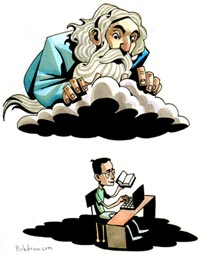 Today was a good time to review the arc of the course: the shape of the trajectory of the Vancouver fiction we have been, are, and will be, studying. I'm posting some notes from lecture on this.
Today was a good time to review the arc of the course: the shape of the trajectory of the Vancouver fiction we have been, are, and will be, studying. I'm posting some notes from lecture on this.- Pauline Johnson: in the face of commercialism and materialism in new-Vancouver, reclaimed a pre-materialist re-vision of the place – Legend, the supra-physical – through her First Nations heritage.
- Some stories – “In Vancouver,” “A Cup of Coffee” – have “Realist” design (pure materialist, "objective” (scientific) description of material fact), but Realism has artistic limitations. (N.b. Current polemical terminology, “Reality-based community,” uses this sense of 'realist.')
- A familiar literary (& fine art, intellectual, & theological) term for this is “Modernism.”
- Munro's “Forgiveness in Families” has a Realist-Modernist tone …. but adds an additional dimension – a secular epiphany -- cued for the reader by the use of an explicitly religious character, the narrator's brother, Cam.
- The epiphany is a recognition of personal failing by the first-person narrator, new knowledge of her own flawed character – and thus the acceptance of personal responsibility, a secular (literay) Confession, producing a new sharing in the human condition.
- This is not religious, and not strictly materialist …. perhaps, in a reserved sense, spiritual?
- Next, Innocent Traveller: a seemingly detached, secular, Modernist narrative stance toward religious characters – e.g. Rachel, Mary, Father – is taken in the text, but a prominently-placed dimension of Eternity is added to this.
- The text straddles straddles a border -- non-religious but refusing to be facilely categorised as plainly scientific: a mystical-Einsteinian engagement with the Infinite.
- Next, poetry and the nearly-now. Margaret Avison takes the modernist scientific-immediate, purely physical attention, (a highly-regarded Modernist poet) to the world, but she then develops into what Douglas Coupland terms “orthodox” – i.e. a specific coherence found in a commited religious position.
- Now, Coupland's Hey Nostradamus! This is Vancouver-Present.
- Coupland has moved beyond modernist attitudes to religion, and beyond religious attitudes to modernism. Also moved beyond anti-religion, and beyond cynicism.
- Takes a playful (ironic) attitude to the religious-anti-religious subject. His explicit treatment of religious character & theme derives from a combined artistic, autobiographical, and intellectual motive.
- To come – William Gibson All Tomorrow’s Parties. As title indicates, Vancouver-Future. A new synthesis. A physicalised spirituality .... in the mode of Blade Runner (Philip K. Dick, Do Androids Dream of Electric Sheep?.)
So, this is the trajectory that the course takes with the particular texts chosen. Any queries, uncertainties, confusions, request for clearer exposition, &c. that you, as they say, "might have," can be left under the comments here, & I'll address mself to them when I can.








 Regarding comments to the blog posts here, they are as you know being Moderated by me: that is, they have to be published by me before they appear on the blog. I turned the Moderator feature on because I had a request to allow Anonymous comments, and that inevitably attracts
Regarding comments to the blog posts here, they are as you know being Moderated by me: that is, they have to be published by me before they appear on the blog. I turned the Moderator feature on because I had a request to allow Anonymous comments, and that inevitably attracts 


 Here are some, I dunno, helpful....informative....enjoyable....pot-stirring.... poetry blogs.
Here are some, I dunno, helpful....informative....enjoyable....pot-stirring.... poetry blogs.



